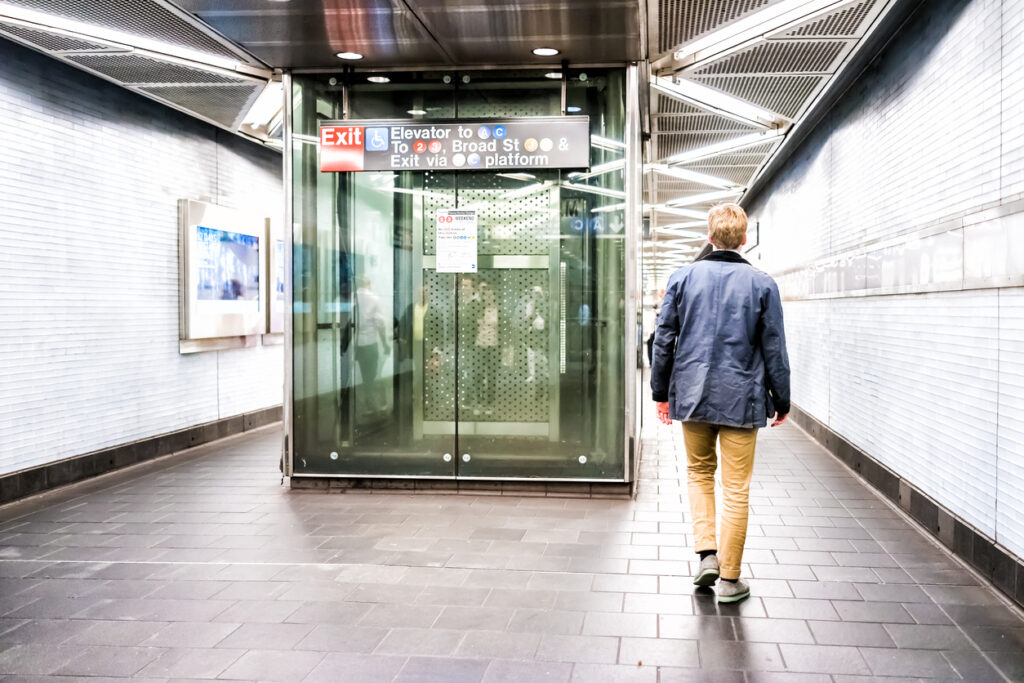
Making New York More Accessible: Zoning for Transit Accessibility Goes to Public Review

A joint City Planning/MTA zoning text amendment with the overriding goal of making the subway system ADA compliant and more accessible is now in public review. Only 136 of its 493 subway stations – 28 percent – have elevators that benefit people with disabilities, parents with young children, seniors, and others. This is an important zoning change (referred to as Zoning for Accessibility or ZFA) that will support the long-term planning needs of mass transit stations and systemwide accessibility by requiring future developments proximate to subway stations to reserve a volume of easement, if needed, for future installation of elevators and lifts.
These requirements have implications for property and developments on lots at least 5000 square feet and within 50 feet of a subway station in most districts in all five boroughs. While approvals would be accomplished through a certification process (no public review), the development community and property owners have expressed concerns about implications for development, and uncertainty about timing and future requirements.
The second major piece of the text amendment expands the subway improvement bonus to high density areas outside Manhattan and Downtown Brooklyn, such as Long Island City, and at the same time expands the eligibility for the bonus, and simplifies the process by making it an authorization (no Council review) rather than a special permit.
Capalino can help you analyze the implications of the proposed requirements on your property, as well as provide guidance on opportunities created by the new subway improvement bonus. If the regulations are adopted, we can also help facilitate the certification process given our long track record working with both the MTA and City Planning on station-related improvements. There is also an opportunity over the next several months to provide feedback to both agencies on potential changes that can reduce risk without undermining the overall goals of transit accessibility. The City Commission will likely hold a public hearing on these amendments later in June.
The ZFA has three principal components:
System-Wide Easement Requirement: Prior to filing for a building permit at DOB, a developer on a qualifying site must first obtain a joint certification from City Planning and the MTA/transit agency as to whether an easement would be required on the site. This requirement would be applicable on sites at least 5000 square feet and within 50 feet of a subway station in the following districts:
- R5D and R6 districts and above (medium- and high-density zoning districts) with and without a commercial overlay
- Commercial districts with a residential equivalent of R5 or above; and
- C7, C8 and manufacturing districts.
The agencies have 60 days to respond to an easement determination, which would be required before an excavation, foundation, new building or alteration permit could be obtained from DOB. If an easement is required, developers would then be required to obtain approval from the MTA/City Planning Chair on a site plan showing the proposed easement volume to accommodate the future transit station improvements. The zoning text allocatees 45 days for this review.
Zoning Relief for Easements: In recognition that a zoning easement could affect development, the zoning amendment provides as-of-right flexibility to accommodate the easements and offset burdens on development potential. This flexibility includes floor area exemption for the easement volume, increasing permitted building height by 10 to 20 feet, and targeted relief from streetwall and lot coverage requirements in certain instances. Parking requirements would be reduced and added flexibility would be allowed for how local retail and other commercial uses are provided within the development. Additional height or parking reductions beyond those to be allowed as of right, could also be pursued through an Authorization or Special Permit to achieve greater design flexibility on unique sites.
Enhanced and Expanded Bonus for Transit Improvements: The current transit station improvement bonus – which allows a 20 percent increase in floor area – is only applicable in high density commercial districts (10 FAR and higher), most of which are located in Midtown, Lower Manhattan, and Downtown Brooklyn. The text amendment would make this bonus applicable in R9 as well as R10 districts beyond Manhattan, and it would be subject to a simpler discretionary approval process by changing the bonus from a Special Permit to an Authorization that would not require full ULURP review or action by the City Council. Importantly, instead of sites having to be directly adjacent to the subway station, the text amendment would expand eligibility by allowing the transit bonus on sites within 1500 feet from a station within the central business districts, and 500 feet in other eligible districts.
Next Steps
The text amendment was referred on April 5 by the City Planning Commission to community boards, Borough Presidents, and Borough Boards for a 60-day review. This will be followed by review and action by the City Planning Commission beginning in late June, and then the City Council. Final approval could occur as early as this Fall.
Capalino has been closely following this text amendment and will draw upon our expertise in real estate, land use, zoning, permitting and lobbying to help clients navigate these developments. If you have any questions about this proposal and how it may affect your property, contact Richard Barth at richard@nullcapalino.com



